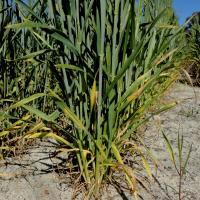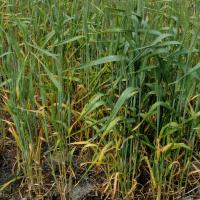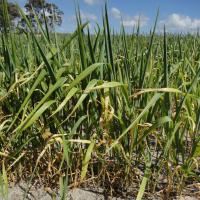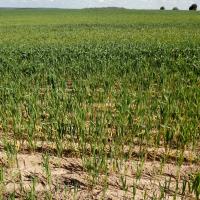Diagnosing potassium deficiency in wheat
Potassium is a major nutrient that is increasingly required as soil reserves become depleted. Potassium deficiency results in poor water use and other nutrients, making crops more susceptible to drought, waterlogging, frost and leaf diseases.
What to look for
- Smaller lighter green plants with necrotic leaf tips, generally on sandier parts of the paddock or between header or swathe rows.
- Plants look unusually water-stressed despite adequate environmental conditions.
- Affected areas are more susceptible to leaf disease.
Paddock
- Plants appear paler and weak.
- Older leaves are affected first with leaf tip death and progressive yellowing and death down from the leaf tip and edges. There is a marked contrast in colour between yellow leaf margins and the green centre.
- Yellowing leaf tip and leaf margins sometimes generates a characteristic green 'arrow' shape towards leaf tip.
Plant
What else could it be
| Condition | Similarities | Differences |
|---|---|---|
| Diagnosing molybdenum deficiency in cereals | Pale plants with leaf tip death. | Potassium deficient plants do not have white or rat-tail heads, and have more marked contrast between yellow and green sections of affected leaves. |
| Diagnosing nitrogen deficiency in wheat | Pale plants with oldest leaves most affected. | Potassium deficient plants have more marked leaf tip death and contrast between yellow and green sections of affected leaves, and tillering is less affected. |
| Diagnosing spring drought in wheat and barley | Water stressed plants with older leaves dying back from the tip, yellowing progressing down from tip and edges and often leaf death occurs. | The main difference is that potassium deficiency is more marked in high growth plants in good seasons. |
| Diagnosing root lesion nematode in cereals | Smaller, water stressed pale plants. | Root lesion nematode affected plants have 'spaghetti' roots with few feeder roots. |
Where does it occur?

Soil type
- Sandy soils and deep grey sandy duplex soils tend to be more susceptible to potassium deficiency.
- High rates of hay or grain removal can result in potassium deficiency.
Management strategies

Top dressing
- Top-dressing potassium will generally correct the deficiency.
- Foliar sprays generally can not supply enough potassium to overcome a severe deficiency and can also scorch crops.
How can it be monitored?

Tissue test
- Use whole-top plant test to diagnose suspected potassium (K) deficiency, and compare paired good/poor plant samples where possible.
- The critical concentration for the whole shoot varies from 4.5% for young plants to about 1.5% at the boot stage.
- The critical level for the 0 - 10 centimetres Colwell K soil test is about 45 - 50 milligrams per kilogram for deeper sands. However for duplex soils K reserves may be present in the clay. Therefore, the reliability of soil test K is frequently improved with K soil test values from deeper in the soil profile.
Further information
Where to go for expert help
Page last updated: Friday, 17 April 2015 - 2:05pm





